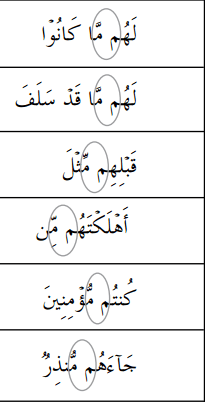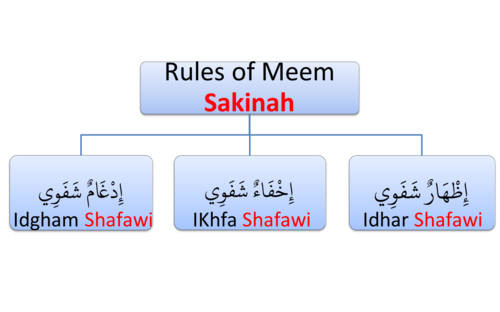As we know it is crucial to read the Quran with Tajweed rules. Tajweed is the science of proper Quranic recitation, and it involves learning the correct way to pronounce each letter, word, and verse of the Quran.
The rules of Tajweed help to preserve the beauty and clarity of the Quranic recitation, and they ensure that the meaning of the verses is conveyed accurately, today we are going to exolain in detail the rule of meem sakinah.
Meem sakinah rules are very important for everyone who wants to recite the Holy Quran correctly
“Meeem Sakinah” is a term used in the science of Tajweed to refer to a specific set of rules governing the pronunciation of the letter “Meem” when it appears with a “Sukoon” (a diacritical mark indicating the absence of a vowel sound) at the end of a word or before another Meem, Baa or any other letter.
There are three rules of Meem Sakinah
Table of Contents
Idgham Shafawi:
When the letter Meem appears before another Meem, it is pronounced by merging both meems together with making them long for two beats which are called (ghunnah). This means that the sound is not held for a long duration, but is rather pronounced quickly and lightly.
1- Idgham Shafawi‘s letters
Idgham shafawi has one letter and it is meem
Idgham shafawi examples

2- Ikhfa Shafawi:
When the letter Meem has a sukoon sound and appears before the letter “Baa”, it is pronounced by hiding and concealing the sound of Meem sakinah with making the meem long.
Ikhfa shafawi letters
Ikhfa shafawi has one letter and it is Ba’
Ikhfa shafawi examples

3- Izhar Shafawi
When the letter Meem appears before all Arabic letters except Meem and Ba’, it is pronounced clearly without adding or hiding anything.
Izhar Shafawi letters
by paying attention to the last two rules we mentioned, we will notice that they have two letters Ba’ and Meem, Izhaar shafawi has the rest 26 letters of the Arabic alphabet
Izhar shafawi examples

The importance of Meeem Sakinah rules: Following the rules of Meeem Sakinah is essential in Tajweed because it ensures the proper pronunciation of the Quranic text. Tajweed rules help to preserve the beauty and clarity of the Quranic recitation and to convey the intended meaning of the verses.
Allah SWT said:
- “And recite the Qur’an with a chant”, i.e., do not rush to read the Qur’an, but rather read it slowly and clearly while reflecting on the meanings.
The Prophet (PBUH) said:
- “The one who is proficient with the Qur’an will be with the noble and righteous scribes (the angels), and the one who reads it and stumbles over it, finding it difficult, will have two rewards.”
Ibn Al-Jazari “Most Famous Tajweed Scholar,” said:
- “The practical application of Tajweed is, without doubt, compulsory. Who does not read the Quran correctly is a sinner”.
Meem sakinah examples
example of Meeem Sakinah with Idgham Shafawi
قل اللهم مَّالك الملك
example of Meeem Sakinah with Ikhfa Shafawi
هم بئاياتنا
example of Meeem Sakinah with izhar Shafawi
لكم دينكم
Here is some additional examples of Meem sakinah rules

– The diffrence between noon sakinah rules and meem sakinah rules
Noon Sakinah and Meem Sakinah are two sets of rules in Tajweed that relate to the pronunciation of the letters Noon and Meem when they appear with a “Sukoon” (a diacritical mark indicating the absence of a vowel sound) at the end of a word or before another letter. Here are some differences between the Noon Sakinah and Meem Sakinah rules:
Idgham:
When Noon Sakinah appears before the letter “Yaa” or “Waw” or”Meem” or “Noon” with a “Sukoon”, it is pronounced with a light nasal sound, and this rule is called “Idgham“.
When Meem Sakinah appears before only the letter Meem, it is pronounced with a merging of the Meem sakinah with the following Meem, and this rule is called “Idgham shafawi”.
Ikhfa:
While both Noon Sakinah and Meem Sakinah can be pronounced with Idgham (merging the sound of the Sakinah letter with the following letter), They can be pronounced with Ikhfa too.
When Meem Sakinah can be pronounced with Idgham Shafawi.
When Meem Sakinah appears before the letter “Baa”, we hide and conceal the Meem with making it long for two beats which is called the Ghunnah sound.
When Noon sakinah Sakinah appears before the following 15 letters (ت – ث – ج – د – ذ – ز – س – ش – ص – ض – ط – ظ – ف – ك – ق) we hide and conceal the Noon sakinah with making it long for two beats which called Ghunnah sound which called Ikhfa
Izhar:
When Meem sakinah appears before all letters except Meem and ba’ we pronounce it clearly without adding or hiding anything which is called Izhar
When Noon sakinah appears before 6 letters called Izhar letters or throat letters and they are:
- ء (Hamzah)
- هـ (Haa)
- ع (Ain)
- ح (Ha)
- غ (Ghain)
- خ (Kha)
we pronounce the Noon sakinah clearly without adding or removing anything
Frequency of occurrence: Meem sakinah is less common than Noon Sakinah in the Quran. While both sets of rules are important to learn for proper Quranic recitation, Meem Sakinah occurs more frequently and is, therefore, more commonly studied in Tajweed courses.
In summary, while both Noon Sakinah and Meem Sakinah are sets of rules in Tajweed that relate to the pronunciation of the letters Noon and Meem when they appear with a “Sukoon”, there are differences in the specific pronunciation and letters that can follow them, as well as in their frequency of occurrence in the Quran.
Conclusion
Meem Sakinah rule is important in Quranic recitation. Tajweed is the science of proper Quranic recitation, and the rules of Meem Sakinah are an essential part of Tajweed.
Following the rules of Meem Sakinah is important for several reasons:
- Accurate Pronunciation: The rules of Meem Sakinah ensure that the Meem letter is pronounced accurately with a complete closure of the lips, followed by a nasal sound. This helps to convey the intended meaning of the Quranic verses accurately.
- Beautification of Recitation: Proper pronunciation of Meem Sakinah enhances the beauty of Quranic recitation by adding a rhythm and melody to the recitation.
- Act of Worship: Muslims believe that reciting the Quran with proper Tajweed is an act of worship. By learning and following the rules of Meem Sakinah, Muslims can show respect and reverence for the divine message of the Quran.
- Preservation of Quranic Text: Tajweed rules, including the rules of Meem Sakinah, help to preserve the integrity and authenticity of the Quranic text. By following the Tajweed rules, Muslims can ensure that the Quranic recitation remains consistent and accurate over time.
In summary, the rules of Meem Sakinah are important in Quranic recitation because they ensure accurate pronunciation, enhance the beauty of recitation, serve as an act of worship, and help to preserve the Quranic text.
-Tajweed is the set of rules and guidelines for proper pronunciation and recitation of the Quran, the holy book of Islam. Tajweed covers various aspects of Quranic recitation, such as the correct pronunciation of Arabic letters and words, proper intonation, and appropriate pauses and emphasis. The aim of Tajweed is to ensure that the Quran is recited with precision, clarity, and beauty, in accordance with the way it was revealed to Prophet Muhammad (peace be upon him) over 1400 years ago. Tajweed is considered a crucial aspect of Islamic education, and many Muslims study it to improve their recitation of the Quran.
The word “Tajweed” comes from the Arabic root “j-w-d”, which means “to make better” or “to improve”. Tajweed, therefore, is the art of improving one’s recitation of the Quran.
Tajweed is not just about the correct pronunciation of letters and words; it also involves understanding the rules of Arabic grammar and syntax, as well as the context and meaning of the verses being recited. This is because the Quranic verses often have multiple layers of meaning, and Tajweed helps to bring out these nuances in the recitation.
Tajweed is an important aspect of Islamic education, and many Muslim children learn it from a young age. There are also specialized schools and teachers who offer more advanced courses in Tajweed for those who wish to master the art.
Tajweed is considered a form of worship, as it involves reciting the words of Allah in the most beautiful and precise manner possible. Muslims believe that reciting the Quran with Tajweed earns them a greater reward from Allah and that it also helps to deepen their spiritual connection with the Quran.
There are many different schools of Tajweed, each with its own set of rules and guidelines. Some of the most well-known schools include the Hafs, Warsh, and Qaloon recitation styles. However, regardless of which school one follows, the ultimate goal of Tajweed is always the same: to recite the Quran in the most perfect and beautiful manner possible.
FAQS
How many rules of Meem sakinah are there
There are three rules of Meem sakinah.
1- izhar and it means to pronounce the meem clearly without doing anything and we apply it when the meem appears before all Arabic letters except meem and ba’.
2- Idgham: to merge the meem sakinah sound with the following letter when it appears before meem.
3- Ikhfa: hiding or concealing the meem sakinah when there is ba ’after.







